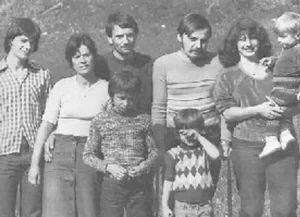 It all happened overnight. The people of East Berlin became prisoners of their government. The government was oppressive, and people wanted to leave. The government could not have that, so walls were put up encircling the city virtually overnight. East Germany was now a part of the Eastern Bloc, and it was separated from West Germany in the Western Bloc by the inner German border and the Berlin Wall, which were heavily fortified with watchtowers, land mines, armed soldiers, and various other measures to prevent illegal crossings. The people were prisoners, and the East German border troops were instructed to prevent defection to West Germany by all means, including lethal force (Schießbefehl; “order to fire”). Many people attempted escape, and many people died trying.
It all happened overnight. The people of East Berlin became prisoners of their government. The government was oppressive, and people wanted to leave. The government could not have that, so walls were put up encircling the city virtually overnight. East Germany was now a part of the Eastern Bloc, and it was separated from West Germany in the Western Bloc by the inner German border and the Berlin Wall, which were heavily fortified with watchtowers, land mines, armed soldiers, and various other measures to prevent illegal crossings. The people were prisoners, and the East German border troops were instructed to prevent defection to West Germany by all means, including lethal force (Schießbefehl; “order to fire”). Many people attempted escape, and many people died trying.
One of the people who refused to give up and settle for imprisonment was Peter Strelzyk (born 1942), an electrician and former East German Air Force mechanic. Strelzyk, along with his friend, Günter Wetzel (born 1955), who was a bricklayer by trade, were determined to get out of East Berlin. The men had been colleagues at a local plastics factory for four years. They had long shared a desire to get out of the country and make a better life for their families. They began discussing, albeit very quietly, how they might make their escape. On March 7, 1978, they decided that they were done living that way and began to plan an escape. Their first thought was to build a helicopter. Then, they realized that they would be unable to acquire an engine capable of powering such a craft. Then, their imaginations alighted on the thought of building a hot air balloon. That idea came about after they watched a television program about ballooning. Some say that they got the idea after a relative shared a magazine article about the International Balloon Festival in Albuquerque, New Mexico. It really doesn’t matter where the idea came from, because they main thing is that they cose a hot air balloon as their escape vehicle.
The decision made, Strelzyk and Wetzel began research into balloons. The plan was to escape with their wives and a total of four children, aged 2 to 15. This was going to have to be a big balloon to hold eight passengers and the basket they would ride in. They calculated the weight of the eight passengers and the craft itself to be around 1,650 pounds. With that in mind, they knew that would need a balloon that could carry the weight would need to hold 71,000 cubic feet of air heated to 212 °F. The next calculation was the amount of material needed for the balloon itself, estimated to be 8,600 square feet.
The pair lived in Pößneck, a small town of about 20,000 where large quantities of cloth could not be obtained without raising attention. There were a number of things that raised suspicion, and a number of people in East Berlin who were all too willing to tell the authorities what they saw and heard. The two men tried neighboring towns of Rudolstadt, Saalfeld, and Jena without success. They travelled 31 miles to Gera, where they were finally able to purchase 3 feet 3 inch wide rolls of cotton cloth totaling 850 2,790 feet in length at a department store after telling the astonished clerk that they needed the large quantity of material to use as tent lining for their camping club.
Wetzel spent two weeks sewing the cloth into a balloon-shaped bag, 49 feet wide by 66 feet long, using a 40-year-old manually operated sewing machine. Strelzyk spent the time building the gondola and burner assembly. The gondola was made from an iron frame, sheet metal floor, and clothesline run around the perimeter every 5.9 inches for the sides. The burner was made using two 24-pound bottles of liquid propane household gas, hoses, water pipe, a nozzle, and a piece of stove pipe.
Finally, in April 1978, the balloon was ready to be tested. For several days, the men searched for just the right spot for the test. The site had to be secluded and yet have a good-sized clearing. They settled on a forest clearing near Ziegenrück, 6.2 miles from the border and 19 miles from Pößneck. Unfortunately, when they tried to inflate the balloon, the heated air from the burner would not move into the balloon. They thought the problem might stem from the fact that they had laid the balloon on the ground. After weeks of additional searching, they found an 82-foot cliff at a rock quarry where they could suspend the balloon vertically before inflation. Unfortunately, that plan also failed.
In the most dramatic invention to date, the men decided to fill the bag with ambient-temperature air before using the burner to raise the air temperature and provide lift. For this, the men constructed a blower with a 14 horsepower 250 cc 15 cubic inch motorcycle engine, started with a Trabant automobile starter powered by jumper cables from Strelzyk’s Moskvitch sedan. The engine, which was quieted by a Trabant muffler. The engine turned 3.3 feet fan blades to inflate the balloon. They also used a home-made flamethrower, similar to the gondola’s burner, to pre-heat the air faster. With these modifications in place, they returned to the secluded clearing to try again, and again the plan failed to inflate the balloon. At this point, they discovered that the cotton material was the problem. It was just too porous, and the heated air quickly seeped out. That unsuccessful attempt had cost them 2,400 DDM. Strelzyk disposed of the cloth by burning it in his furnace over several weeks.
The men went back to the drawing board. Strelzyk and Wetzel purchased samples of different fabrics in local stores, including umbrella material and various samples of taffeta and nylon. Then they used an oven to test the material for heat resistance. They also created a test rig from a vacuum cleaner and a water-filled glass tube to determine which material would allow the vacuum to exert the most suction on the water, and consequently which was the most impervious to air. Of the materials tested, the umbrella covering performed the best, but it was also the most expensive. In the end, they instead selected a synthetic kind of taffeta.
Once again, the men traveled to a distant city to make their purchases so they wouldn’t arouse suspicion. This time they travelled over 100 miles to a department store in Leipzig. Their new cover story was that they belonged to a sailing club and needed the material to make sails. They were extremely worried that the purchase could alert East Germany’s State Security Service (Stasi). Nevertheless, they returned the next day and picked up the material without incident. They paid 4,800 DDM (US$720) for 2,600 feet of 3-foot 3-inch  fabric. On the way home, they also purchased an electric motor to speed up the pedal-operated sewing machine they had been using to sew the material into the desired balloon shape.
fabric. On the way home, they also purchased an electric motor to speed up the pedal-operated sewing machine they had been using to sew the material into the desired balloon shape.
Wetzel spent the next week sewing the material into another balloon. The new motor made the work much faster. Before long they were ready. Soon afterwards, they returned to the forest clearing and inflated the bag in about five minutes using the blower and flame thrower. It was amazing!! Unfortunately, there was s glitch. The bag rose and held air, but the burner on the gondola was not powerful enough to create the heat needed for lift. The pair continued experimenting for months, doubling the number of propane tanks and trying different fuel mixtures. Disappointed with the result, Wetzel decided to abandon the project and instead started to pursue the idea of building a small gasoline engine-powered light aeroplane or a glider.
Strelzyk, however, refused to give up. He continued trying to improve the burner. In June 1979, he discovered that with the propane tank inverted, additional pressure caused the liquid propane to evaporate, which produced a bigger flame. He modified the gondola to mount the propane tanks upside down, and returned to the test site where he found the new configuration produced a 39-foot-long flame. Strelzyk was ready to attempt an escape.
Now down to just four people, the Strelzyk family chose July 3, 1979, and go-day. The weather and wind conditions were favorable. The entire Strelzyk family lifted from a forest clearing at 1:30 am and climbed at a rate of 13 feet per second. They reached an altitude of 6,600 feet according to an altimeter Strelzyk had made by modifying a barometer. A light wind was blowing them towards the border. The balloon then entered clouds, and atmospheric water vapor condensed on the balloon, adding weight which caused it to descend prematurely. The family landed safely…but they were approximately 590 feet short of the border, at the edge of the heavily mined border zone. It was a terrifying situation. At first, they weren’t sure where they were, but Strelzyk explored until he found a piece of litter…a bread bag from a bakery in Wernigerode, an East German town. The terrified family spent nine hours carefully extricating themselves from the 1,600-foot-wide border zone to avoid detection. They also had to travel unnoticed through a 3.1-mile restricted zone before hiking back a total of 8.7 mile to their car and the launch paraphernalia they had left behind. Amazingly, while the balloon was found, their car had not been. They made it home just in time to report absent due to sickness from work and school and go to be to get some much-needed rest.
The abandoned balloon was discovered by the authorities later that morning, and Strelzyk destroyed all compromising evidence and sold his car, fearing that it could link him to the escape attempt. On August 14th, the Stasi launched an appeal to find the “perpetrator of a serious offence” and listed in detail all the items recovered at the landing site. Strelzyk felt that the Stasi would eventually trace the balloon to him and the Wetzels. He agreed with Wetzel that their best chance was to quickly build another balloon and get out as soon as possible.
At this point, Wetzel again joined Strelzyk. They doubled the balloon’s size to 140,000 cubic feet in volume, 66 feet in diameter, and 82 feet in height. They needed 13,500 square feet of taffeta, and purchased the material, in various colors and patterns, all over the country in order to escape suspicion. Wetzel sewed a third balloon, using over 3.7 miles of thread, and Strelzyk rebuilt everything else as before. They worked feverishly, because they knew their time was very limited. The authorities were closing in on them. In six weeks, they had prepared the 400-pound balloon and a payload of 1,210 pound, including the gondola, equipment, and cargo of eight people. Confident in their calculations, they found the weather conditions right on September 15, 1978, when a violent thunderstorm created the correct winds. The two families set off for the launch site in Strelzyk’s replacement car (a Wartburg) and a moped. Arriving at 1:30 am, they needed just ten minutes to inflate the balloon and an additional three minutes to heat the air.
They lifted off just after 2:00 am, and in their hurry, the group failed to cut the tethers holding the gondola to the ground at the same time, tilting the balloon and sending the flame towards the fabric, which caught fire. They quickly got the fire out, because they had prepared for such an emergency. Then the balloon climbed to 6,600 feet in nine minutes, drifting towards West Germany at 9 miles per hour. The balloon flew for 28 minutes, with the temperature plummeting to 18 °F in the unsheltered gondola, which consisted solely of clothesline railing. Nevertheless, they pressed on.
A design miscalculation resulted in the burner stovepipe being too long, causing the flame to be too high in the balloon, creating excessive pressure which caused the balloon to split. While they had to use the burner more that they had hoped, they kept the balloon in the air. At one point, they increased the flame to the maximum possible extent and rose to 8,200 feet. They later learned they had been high enough to be detected, but not identified, on radar by West German air traffic controllers. They had also been detected on the East German side by a night watchman at the district culture house in Bad Lobenstein. The report of an unidentified flying object heading toward the border caused guards to activate search lights, but the balloon was too high and out of reach of the lights. God had protected the families.
When the propane ran out, the balloon descended quickly, landing near the town of Naila, in the West German state of Bavaria and only 6 miles from the border. The only injury was suffered by Wetzel, who broke his leg upon landing. Various clues indicated to the families that the balloon had made it across the border. These included spotting red and yellow colored lights, not common in East Germany, and small farms, in contrast to the large state-run operations in the east. Another clue was modern farm equipment, unlike the older equipment used in East Germany. Two Bavarian State Police officers saw the balloon’s flickering light and headed to where they thought it would land. There they found Strelzyk and Wetzel, who first asked if they had made it to the west, although they noticed the police car was an Audi…another sign they were in West Germany. Upon learning they had, the escapees happily called for their families to join them.
Of course, East Germany immediately increased border security, closed all small airports close to the border, and ordered the planes kept farther inland. Propane gas tanks became registered products, and large quantities of fabric suitable for balloon construction could no longer be purchased. Mail from East Germany to the two escaped families was prohibited.
Erich Strelzyk learned of his brother’s escape on the ZDF news and was arrested three hours after the landing in his Potsdam apartment. The arrest of family members was standard procedure to deter others from attempting escape. He was charged with “aiding and abetting escape”, as were Strelzyk’s sister Maria and her 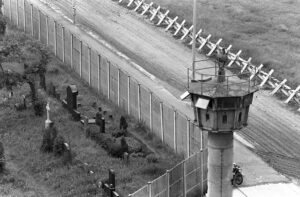 husband, who were sentenced to 2½ years. The three were eventually released with the help of Amnesty International.
husband, who were sentenced to 2½ years. The three were eventually released with the help of Amnesty International.
The families decided to initially settle in Naila where they had landed. Wetzel worked as an automobile mechanic and Strelzyk opened a TV repair shop in Bad Kissingen. Due to pressure from Stasi spies, the Strelzyks moved to Switzerland in 1985. After German reunification in 1990, they returned to their old home in their hometown of Pößneck. The Wetzels remained in Bavaria. Peter Strelzyk died in 2017 at age 74 after a long illness. In 2017, the balloon was put on permanent display at the Haus der Bayerischen Geschichte: Museum in Bavaria.

 My younger daughter, Amy Royce met her future husband, Travis Royce, when they were both still in high school. They knew that what they had was something special…something forever, and now, 29 years later, they are still going strong. They are so good together. They like doing the same things…except for the football teams they support. Travis likes the Chicago Bears and Amy likes the Green Bay Packers. For non-football fans, the two teams are bitter rivals. That said, they watch the games minus their spouse…it keeps the peace.
My younger daughter, Amy Royce met her future husband, Travis Royce, when they were both still in high school. They knew that what they had was something special…something forever, and now, 29 years later, they are still going strong. They are so good together. They like doing the same things…except for the football teams they support. Travis likes the Chicago Bears and Amy likes the Green Bay Packers. For non-football fans, the two teams are bitter rivals. That said, they watch the games minus their spouse…it keeps the peace.
I love how these two are together. Their house is always filled with laughter, because they both have a great sense of humor. Their jokes might be a little different, but both are very funny. They love entertaining their friends, and their house is truly the place everyone wants to hang out. Travis and their son, Caalab, along with several friends have a little band. They don’t usually go anywhere to play or charge admission for their concerts, but rather “jam” right there at the house. When they bought the house, it had a garage and recreation room, and now it is the local “T&Avern” and has everything from a pool table to bar tables. It’s a great place for them, their kids (Shai and Caalab Royce), and their friends to hang out.
Amy and Travis have a couple of places they like to go to celebrate their anniversaries. One is a quaint little 

 place called Ilwaco, in southwest Washington. The town (although I have not been there) reminds me a little bit of a place Bob and I like to go for our anniversaries…Thermopolis, Wyoming. Ilwaco is a little town of about 1,087 people, so there isn’t a whole lot to do but relax and walk around the area. That is what makes it so charming. They also took an Alaskan cruise last year, which they very much enjoyed. Since they live so close to Canada these days, they have also taken anniversary trips to Canada, as well.
place called Ilwaco, in southwest Washington. The town (although I have not been there) reminds me a little bit of a place Bob and I like to go for our anniversaries…Thermopolis, Wyoming. Ilwaco is a little town of about 1,087 people, so there isn’t a whole lot to do but relax and walk around the area. That is what makes it so charming. They also took an Alaskan cruise last year, which they very much enjoyed. Since they live so close to Canada these days, they have also taken anniversary trips to Canada, as well.
Amy and Travis are above all, best friends. They have been from the very start. They have an easy-going style and get along very well. They love the area they love in, being near the beaches, and being near enough to the big cities to go there sometimes, and far enough away so that they aren’t feeling like they are always in the big cities. Amy is a rain-lover!! I don’t know if Travis loves it as much as Amy does, but I think he likes it too. They 
 have a beautiful back yard, that Amy and Travis keep in tip top shape. He takes care the lawn, and she takes care of the flower gardens. They have ponds that are inhabited by “voluntary” frogs and snails. It’s nice when they don’t have to spend money of the inhabitants of the pond, because they just show up and move right in. Amy and Travis are quite happy with their life together, and that makes us very happy too. Today is Am and Travis’ 29th wedding anniversary. Happy anniversary Amy and Travis!! Have a great day!! We love you!!
have a beautiful back yard, that Amy and Travis keep in tip top shape. He takes care the lawn, and she takes care of the flower gardens. They have ponds that are inhabited by “voluntary” frogs and snails. It’s nice when they don’t have to spend money of the inhabitants of the pond, because they just show up and move right in. Amy and Travis are quite happy with their life together, and that makes us very happy too. Today is Am and Travis’ 29th wedding anniversary. Happy anniversary Amy and Travis!! Have a great day!! We love you!!
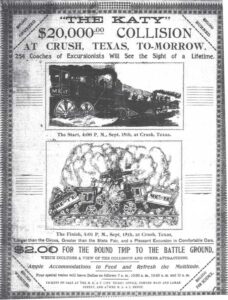
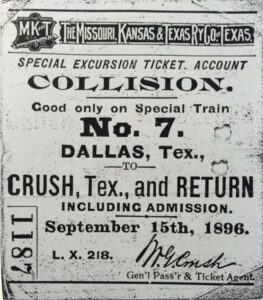 Some of the most horrific kinds of accidents that happen on the railroad are head-on collisions. In these types of accidents, it is almost always the fault of a person, commonly known as “human error.” Once in a while, the signal lights could be defective too, but that is less common than when the person responsible for watching the signal lights is “asleep” at their post, either literally or figuratively. However, on September 15, 1896, neither of these scenarios was the case. Nor was the ensuing crash a terrorist attack. It was actually a planned event. What would make a railway company purposely run two locomotives into each other, head-on? Your guess is as good as mine.
Some of the most horrific kinds of accidents that happen on the railroad are head-on collisions. In these types of accidents, it is almost always the fault of a person, commonly known as “human error.” Once in a while, the signal lights could be defective too, but that is less common than when the person responsible for watching the signal lights is “asleep” at their post, either literally or figuratively. However, on September 15, 1896, neither of these scenarios was the case. Nor was the ensuing crash a terrorist attack. It was actually a planned event. What would make a railway company purposely run two locomotives into each other, head-on? Your guess is as good as mine.
It was actually a publicity stunt. The area north of Waco, was a shallow valley near the tracks of the Missouri, Kansas, and Texas Railroad, also known as the Katy. There was no town there, so a “pop up” town, named Crush, Texas, was formed and was named after William George Crush, who was a passenger agent for the Katy. In 1895, Crush had the crazy idea of staging a train wreck as a way to generate passenger ticket sales. I’m not sure if I would want to buy a ticket for the train, if I had seen the possibility of a head-on collision come to life before my eyes, but apparently some people would. At that time, Texas, like much of the rest of the country, was in a serious economic depression, so Crush convinced the Katy company officials that his scheme would be a creative marketing ploy and attraction. I suppose we all tend to like to watch the spectacular, and a crash of that magnitude…knowing that now one would be hurt…would be interesting.
That summer, the Katy bombarded Texans with advertising for the “Monster Crash.” If they were going to purposely destroy two locomotives and the attached railcars, they wanted plenty of spectators. They put daily preparation reports in many newspapers, and the publicity even stretched beyond the state border. The two locomotives were chosen. They would use Old Number 999, which they painted green, and Number 1001, which they painted red. For a time, they two locomotives toured around to generate interest.
Thousands of Texans came out to see the locomotives during their tour, and then in early September several hundred Katy workmen began staging the town. Obviously not wanting to shut down the main line tracks for the cleanup that would have to follow the crash, they laid four miles of track off of the Waco-Dallas line that would be at a slight downward grade for both engines to the point of impact. A grandstand was constructed, along with three speaker’s stands, a bandstand, telegraph office, and a circus tent to act as a restaurant. The atmosphere was set with a huge carnival midway that featured game booths, drink stands, and medicine 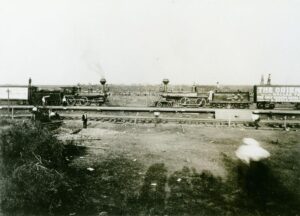 shows. And to put the final touch, they erected a special depot with a 2,100-foot platform and a sign welcoming passengers to Crush, Texas. I suppose it was similar to staging a movie these days.
shows. And to put the final touch, they erected a special depot with a 2,100-foot platform and a sign welcoming passengers to Crush, Texas. I suppose it was similar to staging a movie these days.
It was a known fact that in most collisions of this type, the engines would force each other up into a V and the rest of the cars would accordion behind them, making a boiler explosion less likely. Still, they didn’t want to take any chances, so they set up a safety perimeter of 150 yards around the pre-determined collision point and no one would be allowed in the danger zone. Crush told reporters, “The place selected for the collision is a natural amphitheater, and nobody will have any trouble viewing the entire exhibition.”
Tickets to the event were priced at $2.00, and they expected about 20,000 prople from around the state. What they got, was 40,000 people, and some passengers had too ride on top of railcars to get to the site. On that one day, the town of Crush, Texas became the second largest city in Texas. The event was scheduled for 4pm, but since people were still coming into town, they delayed the collision by one hour. Finally, at 5pm, the two locomotives, each pulling six cars moved into position at opposite ends of the four-mile track. Finally, the spectacle was ready. Crush rode a white horse to the middle of the track, raised his white hat, then after a dramatic pause, whipped it down as the signal for the engines to start. The crowd pressed forward for a better view, and the locomotive crews jumped to safety leaving the massive 35-ton iron monsters on their 50 mile per hour course to disaster. For dramatic effect, the Katy employees had placed small charges along the rail line to create warning blasts as the locomotives passed them.
Unfortunately, Crush and Katy rail officials had underestimated just how powerful the collision would be. The trains hit with between 1 and 2 million pounds of force, and despite what the engineers thought would happen, the boilers on both exploded. The sound of the collision was deafening, and the collision filled the air with flying metal. The panicked crowds tried to run to safety. The debris, ranging from the size of a postage stamp to half a driving wheel, rained down of the crowd for about 300 yards. Sadly, not everyone would make it out alive. At least two people were killed, and several injured. Shockingly, some of the injuries occurred after the crash when spectators rushed to collect souvenirs, not realizing it would burn their hands. Waco based photographer Jervice Deane, lost his right eye to a flying bolt that lodged in his skull. Amazingly, he survived the injury.
The planned disaster was quickly cleaned up by railroad crews and souvenir hunters, and by nightfall, the town of Crush ceased to exist. For his part in all this, Katy rail officials fired George Crush that night, because they 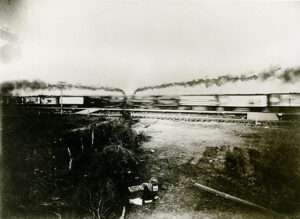
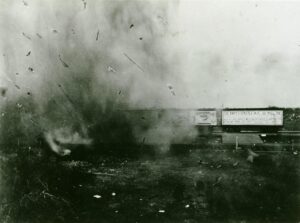 were anticipating a large backlash and lawsuits resulting from the larger than expected explosion. Nevertheless, the publicity stunt worked, train ticket sales increased. In a “back by popular demand” kind of move, Crush was re-hired within days. His days as a showman, however, were over. The railroad quietly settled the resulting lawsuits with cash and lifetime rail passes. Crush stayed on with the railroad until his retirement in 1940.
were anticipating a large backlash and lawsuits resulting from the larger than expected explosion. Nevertheless, the publicity stunt worked, train ticket sales increased. In a “back by popular demand” kind of move, Crush was re-hired within days. His days as a showman, however, were over. The railroad quietly settled the resulting lawsuits with cash and lifetime rail passes. Crush stayed on with the railroad until his retirement in 1940.

 Many little girls dream of becoming a princess. They may not dream of it for long, before reality sets in, but at some point, most little girls want to be a princess, even if it is just Cinderella. For one actress, Grace Kelly, that dream came true on April 18, 1956, when she married Prince Rainier III of Monaco. The couple met the year before at the Cannes Film Festival, went on to have three children…Caroline, born January 23, 1957; Albert II, born March 14, 1958; and Stephanie, born February 1, 1965.
Many little girls dream of becoming a princess. They may not dream of it for long, before reality sets in, but at some point, most little girls want to be a princess, even if it is just Cinderella. For one actress, Grace Kelly, that dream came true on April 18, 1956, when she married Prince Rainier III of Monaco. The couple met the year before at the Cannes Film Festival, went on to have three children…Caroline, born January 23, 1957; Albert II, born March 14, 1958; and Stephanie, born February 1, 1965.
Grace Kelly, the daughter of a former model and a wealthy industrialist, was born on November 12, 1929, in Philadelphia. Her talent was obvious early on, and she began acting as a child. Then, after high school, she attended the American Academy for Dramatic Arts in New York. She had found her niche…or so she thought.  After her schooling, she began to audition for Broadway plays. She was a classic blonde beauty, who supported herself by modeling and appearing in TV commercials, while awaiting her “big break.”
After her schooling, she began to audition for Broadway plays. She was a classic blonde beauty, who supported herself by modeling and appearing in TV commercials, while awaiting her “big break.”
In 1949, Kelly debuted on Broadway in a play called “The Father” by August Strindberg. She was on her way. Then two years later, she landed her first Hollywood part. Granted, it was a bit part, in a movie called “Fourteen Hours,” but it was a part. Her big break came in 1952, when she starred as Gary Cooper’s wife in the Western “High Noon.” Her performance in 1954’s “The Country Girl,” as the wife of an alcoholic actor and singer played by Bing Crosby, won her a Best Actress Oscar (Kelly beat out Judy Garland in “A Star is Born”). Among Kelly’s other acting credits were three Alfred Hitchcock thrillers: “Dial M for Murder” (1954), with Ray Milland and Robert Cummings, Rear Window (1954), with James Stewart, and “To Catch a Thief,” with Cary Grant. Her last big-screen role was in 1956’s “High Society,” a musical adaptation of 1940’s The Philadelphia Story, co-starring Bing Crosby and Frank Sinatra. By this time, Grace Kelly was on her way to retirement from the movies, because she was about to become a “real-life” princess. That little girl dream was going to come true for her…and for a number of years, Grace Kelly lived that dream.
Then, on September 14, 1982, her dream came to an end. Princess Grace of Monaco…the American-born 
 former film star Grace Kelly, whose movie credits include The Country Girl and Rear Window, and who was known as the darling of the United States, and the dream of many little girls, died at the age of 52 from injuries suffered after her car plunged off a mountain road near Monte Carlo. Princess Grace was driving with her youngest daughter, Stephanie, when she reportedly suffered a stroke and lost control of her car, which plunged down a mountainside. Seventeen-year-old Stephanie survived, but Princess Grace died the following day. Her death was mourned by millions of fans around the world.
former film star Grace Kelly, whose movie credits include The Country Girl and Rear Window, and who was known as the darling of the United States, and the dream of many little girls, died at the age of 52 from injuries suffered after her car plunged off a mountain road near Monte Carlo. Princess Grace was driving with her youngest daughter, Stephanie, when she reportedly suffered a stroke and lost control of her car, which plunged down a mountainside. Seventeen-year-old Stephanie survived, but Princess Grace died the following day. Her death was mourned by millions of fans around the world.

 Every kid gets excited about their birthday and being another year older. Most start saying they are their age and a half pretty early on, but for my grandniece, Mackenzie Moore, the excitement maybe went to the extreme. In fact, she’s been talking about turning seven since she turned six!! Hahaha!! So, to think the day has finally arrived is…well, the best birthday gift ever!! Oh, don’t get me wrong, I’m sure she is excited about birthday gifts and such, but being seven is just the coolest most important part of her birthday.
Every kid gets excited about their birthday and being another year older. Most start saying they are their age and a half pretty early on, but for my grandniece, Mackenzie Moore, the excitement maybe went to the extreme. In fact, she’s been talking about turning seven since she turned six!! Hahaha!! So, to think the day has finally arrived is…well, the best birthday gift ever!! Oh, don’t get me wrong, I’m sure she is excited about birthday gifts and such, but being seven is just the coolest most important part of her birthday.
Mackenzie is kind, and she has such a sweetheart. Like her mom, Lindsay Moore, Mackenzie is a social butterfly…she is a friend to everyone she meets. Mackenzie is truly a such a delightful person. She is easy going and fun. She loves her family and loves to be with them. Her grandmas and grandpas, aunts and uncles, and most of all…her cousins are a huge part of her life!! The summer, she got to spend time with her cousin Khloe from South Dakota; and lots of time with Adelaide Sawdon, who lives in Cheyenne, so not too far away. She and Addie play together often, and we try to get the girls together a lot. They build forts, make up games, and love to jump on the trampoline. Then, Mackenzie and Adelaide got to go camping with cousins, Ethan and Aurora Hadlock, and Jolene Thompson . The Hadlock family has had a long-standing tradition of camping together, and that has built a close comradery among the cousins. 

 Chelsea tells me that, Mackenzie is very funny, kind, and determined…and she is never interested in Uncle Ryan Hadlock’s teasing and nonsense. Hahahaha!!
Chelsea tells me that, Mackenzie is very funny, kind, and determined…and she is never interested in Uncle Ryan Hadlock’s teasing and nonsense. Hahahaha!!
She spent a lot of time practicing her gymnastics this summer and started officially this fall. So far, she loves it. and her hard work has paid off. She is very proud of her gymnastics skills and loves to show those skills as often as possible. She’s practiced the perfect cartwheel and executes it flawlessly each time she does it. Her aunt, Chelsea Hadlock, tells me that she is super good at them!! When Chelsea asked what she wanted for her birthday she said, “makeups and lotions, lip ‘skincare,’ soft scrunchies…Simone Biles things.” Chelsea really laughed about that. For those who don’t know, Simone Biles is an Olympic gymnast.
Mackenzie loves her daddy, Shannon Moore, very much!! They are two peas in a pod, and they love doing the same things. She also loves being in 1st grade!! Mackenzie has the sweetest heart. She is always considerate of everyone around her to make sure they are included and comfortable in all situations. She is a helper and always does what is right. She is also such a sweet friend. One place where Mackenzie shows maybe just a “hint” of stubbornness, is in the area of fashion. She has her own style, and it may not be like everyone else. 
 That doesn’t matter, because it is her style. She’s always been this way and knows exactly what she wants her outfits and hair to look like and will not be swayed, haha!! Her Aunt Jessi Sawdon and family love that they live so close and get to see her often! God has made her uniquely her…instilling her perfect gifts and talents. He has called her according to a purpose!! She is loved by God, loved by her family and her sweet little doggy Brinkley Bear. Today is Mackenzie’s 7th birthday!! You made it Mackenzie…six is gone and seven has arrived. Happy birthday Mackenzie!! Have a great day!! We love you!!
That doesn’t matter, because it is her style. She’s always been this way and knows exactly what she wants her outfits and hair to look like and will not be swayed, haha!! Her Aunt Jessi Sawdon and family love that they live so close and get to see her often! God has made her uniquely her…instilling her perfect gifts and talents. He has called her according to a purpose!! She is loved by God, loved by her family and her sweet little doggy Brinkley Bear. Today is Mackenzie’s 7th birthday!! You made it Mackenzie…six is gone and seven has arrived. Happy birthday Mackenzie!! Have a great day!! We love you!!
 It would be hard for many of us to understand how devastating it would be to go to sleep one night and wake up the next morning to a world that doesn’t remotely resemble the one we went to sleep in the night before. Nevertheless, that is exactly what the people of Santiago, Chile woke up to on September 11, 1973. Their world exploded in chaos. They never saw it coming. That fateful day, residents of the Chilean capital, Santiago, awoke to tanks rolling along the streets and the declaration of a coup. Salvador Allende, the first democratically elected Marxist leader in Latin America, had been deposed by a military junta under the direction of Augusto Pinochet. I would have thought that deposing a Marxist would have been a good thing, but I suppose it depends on what he is replaced by. Time would tell the horrific tale. In the months that followed, some 3,000 people, including two Americans, were be rounded up, tortured, and executed. September 11, 1973, began a dictatorship that would last 17 years. The first “new reality” was the sight of their own fighter jets bombing La Moneda, the presidential palace. I’m sure that sight burned into their memories, much like the sight of our own White House being bombed would do to us in the United States. Like the attacks of 9-11 in the United States, this was something you never forget.
It would be hard for many of us to understand how devastating it would be to go to sleep one night and wake up the next morning to a world that doesn’t remotely resemble the one we went to sleep in the night before. Nevertheless, that is exactly what the people of Santiago, Chile woke up to on September 11, 1973. Their world exploded in chaos. They never saw it coming. That fateful day, residents of the Chilean capital, Santiago, awoke to tanks rolling along the streets and the declaration of a coup. Salvador Allende, the first democratically elected Marxist leader in Latin America, had been deposed by a military junta under the direction of Augusto Pinochet. I would have thought that deposing a Marxist would have been a good thing, but I suppose it depends on what he is replaced by. Time would tell the horrific tale. In the months that followed, some 3,000 people, including two Americans, were be rounded up, tortured, and executed. September 11, 1973, began a dictatorship that would last 17 years. The first “new reality” was the sight of their own fighter jets bombing La Moneda, the presidential palace. I’m sure that sight burned into their memories, much like the sight of our own White House being bombed would do to us in the United States. Like the attacks of 9-11 in the United States, this was something you never forget.
The Presidential Palace in Chile is basically the Chilean White House, and suddenly it was blown to bits. The bombing took place at 11am, just moments after the coup had been announced. Allende and his most loyal followers were still inside, which was not the best place to be. While La Moneda was in flames, President Allende committed suicide with an AK-47. I’m sure he would have been killed anyway, but quite likely his death would not come until after he was tortured first.
Although the bombing of La Moneda marked the beginning of a long period of repression and misery in Chile, it  also capped off a somewhat embarrassing period for the USA. The United States was not supportive of Allende’s regime either, and “under the orders of Richard Nixon, the CIA (as its own website attests) had spent the previous three years helping plot coups in Chile and trying to otherwise destabilize Allende’s government. Another foreign policy success!” Ironically, the democratically elected Allende was succeeded by the brutal dictator General Augusto Pinochet, who ruled over Chile with an iron fist for the next 17 years.
also capped off a somewhat embarrassing period for the USA. The United States was not supportive of Allende’s regime either, and “under the orders of Richard Nixon, the CIA (as its own website attests) had spent the previous three years helping plot coups in Chile and trying to otherwise destabilize Allende’s government. Another foreign policy success!” Ironically, the democratically elected Allende was succeeded by the brutal dictator General Augusto Pinochet, who ruled over Chile with an iron fist for the next 17 years.
While Allende was democratically elected, he was also a Marxist leader and so not really what the United States wanted to see for Chile. When the coup began, Allende retreated with his supporters to La Moneda. The Presidential palace was a fortress-like structure. Pinochet’s army surrounded the palace with tanks and infantry and ordered air force jets to bomb it. Allende survived the aerial attack but then apparently shot himself to death as troops stormed the burning palace, reportedly using an automatic rifle given to him as a gift by Cuban dictator Fidel Castro.
Allende was born into an upper-middle-class Chilean family in 1908. By 1933, he was a Marxist activist and worked as a doctor and was a founding member of Chile’s Socialist Party. He was elected to the Chamber of Deputies in 1937 and later served as minister of health in the leftist government of President Pedro Aguirre Cerda. His political career continued to grow, and in 1945, he became a senator. Then, he suffered a bit of a setback when he ran for president several times in the 1950s and 1960s but lost. Then in September 1970 he won a three-sided presidential race with 36.3 percent of the vote, but without a clear majority, his election had to be confirmed by the Chilean Congress. Once confirmed, Allende became president.

After Allende was declared the victor, President Richard Nixon summoned CIA Director Richard Helms to the White House and ordered him in no uncertain terms to prevent Allende from coming to power or to unseat him. Nixon knew that Allende had threatened to nationalize US owned industries in Chile. Nixon did not want another Fidel Castro coming to power in an American hemisphere during his watch. It was a serious concern, so President Nixon authorized $10 million for the covert operation against Allende and instructed that it be carried out without the knowledge of the US embassy in Chile. In the end, the “problem” was solved by the coup that took place. Of course, the solution was just as bad, if not worse than the original problem.

 When I look back on the events of September 11, 2001, I find it really hard to believe that it has been 23 years already. So many lives lost…moms and dads, brothers and sisters, sons and daughters. The children born right after losing a parent to the 911 Attacks are grown now. Some may have begun their own families. All of the children who lost loved ones are adults, for whom the ramifications of those attacks are very real. They lost a parent, and some never got to know their parent. Of course, for anyone who lost someone in the attacks, the ramifications are very real. You don’t ever lose a loved one without feeling the immense pain of that loss, and when that loss comes from a brutal and unwarranted attack it especially hard to wrap your head around it. Why?? That is the ultimate question, and in this case the one that was never really answered, except to say that a deranged monster had an “imagined score” to settle.
When I look back on the events of September 11, 2001, I find it really hard to believe that it has been 23 years already. So many lives lost…moms and dads, brothers and sisters, sons and daughters. The children born right after losing a parent to the 911 Attacks are grown now. Some may have begun their own families. All of the children who lost loved ones are adults, for whom the ramifications of those attacks are very real. They lost a parent, and some never got to know their parent. Of course, for anyone who lost someone in the attacks, the ramifications are very real. You don’t ever lose a loved one without feeling the immense pain of that loss, and when that loss comes from a brutal and unwarranted attack it especially hard to wrap your head around it. Why?? That is the ultimate question, and in this case the one that was never really answered, except to say that a deranged monster had an “imagined score” to settle.
A total of 2,977 people were killed in New York City, Washington, DC and outside of Shanksville, Pennsylvania on September 11, 2001. Of those, 2,753 were killed at the World Trade Center site in Lower Manhattan. These consisted of victims from hijacked American Airlines Flight 11 and United Airlines Flight 175 both of which were  intentionally crashed into the North and South Towers, or as a result of the crashes. Of those who perished during the initial attacks and the subsequent collapses of the Towers, 343 were New York City firefighters, 23 were New York City police officers and 37 were officers at the Port Authority. The victims ranged in age from two to 85 years. Approximately 75-80% of the victims were men. A total of 184 people were killed at the Pentagon in Washington, when hijacked American Airlines Flight 77 crashed into the building. Near Shanksville, Pennsylvania, 40 passengers and crew members aboard United Airlines Flight 93 died when the plane crashed into a field. It is believed that the hijackers crashed the plane in that location, rather than their unknown target, after the passengers and crew attempted to retake control of the flight deck. As of January 18, 2024, 1,650 of 2,753 WTC victims’ remains have been positively identified, according to the medical examiner’s office…which means that the families of 1,103 people have not been able to have closure. Unfortunately, the fact remains that many will never be identified.
intentionally crashed into the North and South Towers, or as a result of the crashes. Of those who perished during the initial attacks and the subsequent collapses of the Towers, 343 were New York City firefighters, 23 were New York City police officers and 37 were officers at the Port Authority. The victims ranged in age from two to 85 years. Approximately 75-80% of the victims were men. A total of 184 people were killed at the Pentagon in Washington, when hijacked American Airlines Flight 77 crashed into the building. Near Shanksville, Pennsylvania, 40 passengers and crew members aboard United Airlines Flight 93 died when the plane crashed into a field. It is believed that the hijackers crashed the plane in that location, rather than their unknown target, after the passengers and crew attempted to retake control of the flight deck. As of January 18, 2024, 1,650 of 2,753 WTC victims’ remains have been positively identified, according to the medical examiner’s office…which means that the families of 1,103 people have not been able to have closure. Unfortunately, the fact remains that many will never be identified.
One can only hope and pray that these family can find peace. Their loved ones did nothing wrong. They were 
 simply going about their normal day. They had no idea when they woke up that morning, that by the end of the day, their lives would be over, and their families would be thrown into extreme grieving. We must also hope that those of us who are left behind can somehow find a way to be kinder to each other. It is the only way to heal some of the pain people go through in their everyday lives. Today, we remember those we lost on September 11, 2001, and those left behind to carry on.
simply going about their normal day. They had no idea when they woke up that morning, that by the end of the day, their lives would be over, and their families would be thrown into extreme grieving. We must also hope that those of us who are left behind can somehow find a way to be kinder to each other. It is the only way to heal some of the pain people go through in their everyday lives. Today, we remember those we lost on September 11, 2001, and those left behind to carry on.
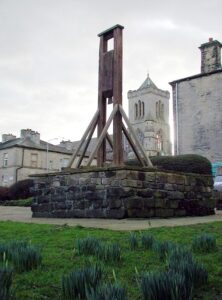
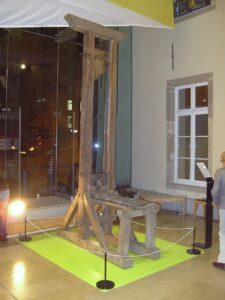 Death by guillotine…just the thought makes us cringe. Nevertheless, this form of the death sentence has been widely used throughout history, though not anymore. The last person to be executed by guillotine was Hamida Djandoubi, a Tunisian immigrant convicted of murder. He was executed at Baumetes Prison in Marseille, France. A guillotine is “an apparatus designed for efficiently carrying out executions by beheading. The device consists of a tall, upright frame with a weighted and angled blade suspended at the top. The condemned person is secured with a pillory at the bottom of the frame, holding the position of the neck directly below the blade. The blade is then released, swiftly and forcefully decapitating the victim with a single, clean pass; the head falls into a basket or other receptacle below.” While it might be a quick, clean, and efficient form of execution, it is one that brings thoughts of horror to most people.
Death by guillotine…just the thought makes us cringe. Nevertheless, this form of the death sentence has been widely used throughout history, though not anymore. The last person to be executed by guillotine was Hamida Djandoubi, a Tunisian immigrant convicted of murder. He was executed at Baumetes Prison in Marseille, France. A guillotine is “an apparatus designed for efficiently carrying out executions by beheading. The device consists of a tall, upright frame with a weighted and angled blade suspended at the top. The condemned person is secured with a pillory at the bottom of the frame, holding the position of the neck directly below the blade. The blade is then released, swiftly and forcefully decapitating the victim with a single, clean pass; the head falls into a basket or other receptacle below.” While it might be a quick, clean, and efficient form of execution, it is one that brings thoughts of horror to most people.
The guillotine first gained fame, when physician and revolutionary Joseph-Ignace Guillotin won passage of a law 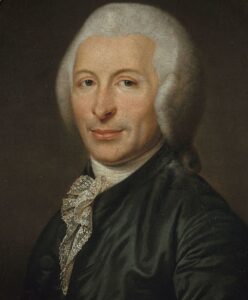 requiring all death sentences to be carried out by “means of a machine” during the French Revolution. This was not the first use of decapitating machines, however. They had been used earlier in Ireland and England. Guillotin and his supporters viewed these devices as more humane than other execution techniques, such as hanging or firing squad. I suppose I can see that, because both hangings and firing squad executions have gone wrong, and the guilty party suffered a prolonged period of agony before finally succumbing to their fate. To bring about a death that was more instantaneous, although not without agony…considering the moments before the blade dropped, the guillotine was brought into the mainstream of executions. A French decapitating machine was built and tested on cadavers. On April 25, 1792, a highwayman became the first person in Revolutionary France to be executed by this method.
requiring all death sentences to be carried out by “means of a machine” during the French Revolution. This was not the first use of decapitating machines, however. They had been used earlier in Ireland and England. Guillotin and his supporters viewed these devices as more humane than other execution techniques, such as hanging or firing squad. I suppose I can see that, because both hangings and firing squad executions have gone wrong, and the guilty party suffered a prolonged period of agony before finally succumbing to their fate. To bring about a death that was more instantaneous, although not without agony…considering the moments before the blade dropped, the guillotine was brought into the mainstream of executions. A French decapitating machine was built and tested on cadavers. On April 25, 1792, a highwayman became the first person in Revolutionary France to be executed by this method.
Though it was not originally named a “guillotine,” the device soon became known as such after its advocate, Joseph-Ignace Guillotin. Through the use of the device, more than 10,000 people lost their heads during the 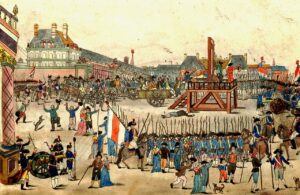
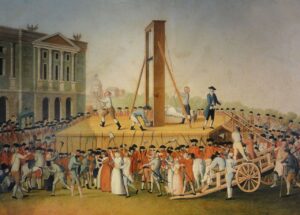 Revolution, including Louis XVI and Marie Antoinette, the former king and queen of France. France continued to us the guillotine during the 19th and 20th centuries, and incredibly, the last execution by guillotine occurred in 1977. Then, France outlawed capital punishment altogether in September 1981, and so the guillotine was abandoned forever. There is a museum dedicated to the guillotine in Liden, Sweden.
Revolution, including Louis XVI and Marie Antoinette, the former king and queen of France. France continued to us the guillotine during the 19th and 20th centuries, and incredibly, the last execution by guillotine occurred in 1977. Then, France outlawed capital punishment altogether in September 1981, and so the guillotine was abandoned forever. There is a museum dedicated to the guillotine in Liden, Sweden.

 My youngest grandson, Josh Petersen ended his 25th year of life by packing up his wife, Athena Petersen and their sons, Justin and Axel, and moving them to Lawton, Oklahoma. The day they left town was such a sad day for those of us left behind, and while it was also sad for them, they went with a sense of adventure too. I can’t blame them for feeling the excitement of the move, but of course, I am one of those left behind. For us, their parents, grandparents, siblings, niece and nephews, there is an empty space that now lives in our lives. Nevertheless, we will find creative ways to stay close to these loved ones too.
My youngest grandson, Josh Petersen ended his 25th year of life by packing up his wife, Athena Petersen and their sons, Justin and Axel, and moving them to Lawton, Oklahoma. The day they left town was such a sad day for those of us left behind, and while it was also sad for them, they went with a sense of adventure too. I can’t blame them for feeling the excitement of the move, but of course, I am one of those left behind. For us, their parents, grandparents, siblings, niece and nephews, there is an empty space that now lives in our lives. Nevertheless, we will find creative ways to stay close to these loved ones too.
Josh will begin his 26th year with a new job. He is still doing the same work he was in Casper…recharging fire 
 extinguishers, but now he will be working at Fire Pros, LLC in Lawton. This was a step up for him, as he is making five dollars more an hour than he was here in Casper. Josh has to improve himself, especially when he and Athina are expecting their third son at the end of January. He rather fell into this work and was trained well at All Out Fire in Casper, and his new employer saw the great value in having a pre-trained employee on staff. He jumped at the chance to hire Josh. Josh had wanted to be a firefighter when he went to college, but his knees would not allow him to do so. This is for him, the next best option. It may not always be what he wants to do, but I know that whatever he decides to do, he will excel at, because Josh is a hardworking man, who is very loyal to his employers. He always has been, and we are very proud of his work ethic.
extinguishers, but now he will be working at Fire Pros, LLC in Lawton. This was a step up for him, as he is making five dollars more an hour than he was here in Casper. Josh has to improve himself, especially when he and Athina are expecting their third son at the end of January. He rather fell into this work and was trained well at All Out Fire in Casper, and his new employer saw the great value in having a pre-trained employee on staff. He jumped at the chance to hire Josh. Josh had wanted to be a firefighter when he went to college, but his knees would not allow him to do so. This is for him, the next best option. It may not always be what he wants to do, but I know that whatever he decides to do, he will excel at, because Josh is a hardworking man, who is very loyal to his employers. He always has been, and we are very proud of his work ethic.
Josh is also a loyal family man and is always willing to sacrifice his needs to make sure his wife and sons have everything they need. Josh met Athena when they were in middle school, and as often happens, they didn’t 
 know that this was their forever love, until much later when they ended up working together. I think they knew the minute they found out they were working together, however. The rest is history, as they say. In short order they were married, had two sons, and have one on the way. They love taking the boys to the park, and other places of interest…and they take lots of pictures, which we will all treasure even more now. We want them to be happy, and their lives to be full, but as long as they live away from us, we will all miss them very much. Nevertheless, as they have said before, “Home is Wherever I’m With You” and so it is. Today is Josh’s 26th birthday. Happy birthday Josh!! Have a great day!! We love you!!
know that this was their forever love, until much later when they ended up working together. I think they knew the minute they found out they were working together, however. The rest is history, as they say. In short order they were married, had two sons, and have one on the way. They love taking the boys to the park, and other places of interest…and they take lots of pictures, which we will all treasure even more now. We want them to be happy, and their lives to be full, but as long as they live away from us, we will all miss them very much. Nevertheless, as they have said before, “Home is Wherever I’m With You” and so it is. Today is Josh’s 26th birthday. Happy birthday Josh!! Have a great day!! We love you!!
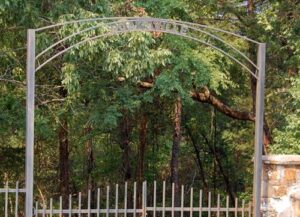
 Many factors go into the “make or break” status of a town. Sometimes, it’s all about location. Other times, it’s about what is built after the town is formed. Still other times, it’s about what is discovered there and how low its supply lasts. The town of Doaksville, Oklahoma was once the largest town in the Choctaw Nation. Doaksville was founded in the early 1820s when Josiah S Doaks and his brother established a trading post. It was a humble beginning that sprang from the anticipation of the arrival of the Choctaw Indians to the area after the signing of the Treaty of Doak’s Stand in October 1820. The brothers moved westward with their boats filled with goods for the trading post and headed up the Mississippi and Red Rivers. Soon, other settlers moved into the area to be close to the store for mutual protection.
Many factors go into the “make or break” status of a town. Sometimes, it’s all about location. Other times, it’s about what is built after the town is formed. Still other times, it’s about what is discovered there and how low its supply lasts. The town of Doaksville, Oklahoma was once the largest town in the Choctaw Nation. Doaksville was founded in the early 1820s when Josiah S Doaks and his brother established a trading post. It was a humble beginning that sprang from the anticipation of the arrival of the Choctaw Indians to the area after the signing of the Treaty of Doak’s Stand in October 1820. The brothers moved westward with their boats filled with goods for the trading post and headed up the Mississippi and Red Rivers. Soon, other settlers moved into the area to be close to the store for mutual protection.
There were raids from the Plains Indians, especially those from Texas, which necessitated the establishment in 1824, of nearby Fort Towson. With the establishment of the fort, Doaksville began to grow and had all the makings of becoming a permanent town. Roads were built, between Doaksville, the trading post, and Fort Towson to establish a supply line. Doaksville sat at the center of these crossroads, and Doaksville began to prosper from the Central National Road of Texas that ran from Dallas to the Red River before connecting with the Fort Towson Road, which went on to Fort Gibson and beyond to Fort Smith, Arkansas. Doaksville seemed to be right in the thick of things. In addition, steamboats on the Red River connected with New Orleans at a public landing just a few miles south of Doaksville, carrying supplies to Fort Towson and agriculture products out of the region. It looked like Doaksville was headed for greatness.
Then, in 1837, the Choctaw and the Chickasaw signed the Treaty of Doaksville, which allowed the Chickasaw to lease the westernmost portion of the Choctaw Nation for settlement. By 1840, Doaksville was really growing. It now sported five large merchandise stores, two of which were owned by Choctaw Indians and the others by licensed white traders. There was a harness and saddle shop, wagon yard, blacksmith shop, gristmill, hotel, council house, and church. A newspaper called the Choctaw Intelligencer…printed in both English and Choctaw.
Of course, with the settlement came the missionaries. A missionary named Alvin Goode described the settlement at the time, “The trading establishment of Josiah Doak and Vinson Brown Timms, an Irishman, had the contract to supply the Indians their rations, figured at 13 cents a ration. A motley crowd always assembled 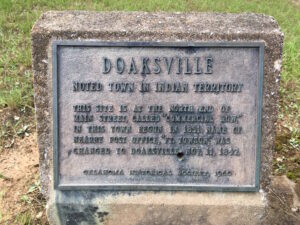 at Doaksville on annuity days to receive them. Some thousands of Indians were scattered over a nearly square mile tract around the pay house. There were cabins, tents, booths, stores, shanties, wagons, carts, campfires; white, red, black and mixed in every imaginable shade and proportion and dressed in every conceivable variety of style, from tasty American clothes to the wild costumes of the Indians; buying, selling, swapping, betting, shooting, strutting, talking, laughing, fiddling, eating, drinking, smoking, sleeping, seeing and being seen, all bundled together.”
at Doaksville on annuity days to receive them. Some thousands of Indians were scattered over a nearly square mile tract around the pay house. There were cabins, tents, booths, stores, shanties, wagons, carts, campfires; white, red, black and mixed in every imaginable shade and proportion and dressed in every conceivable variety of style, from tasty American clothes to the wild costumes of the Indians; buying, selling, swapping, betting, shooting, strutting, talking, laughing, fiddling, eating, drinking, smoking, sleeping, seeing and being seen, all bundled together.”
The town of Doaksville continued to grow, and in 1847 a post office was established. By 1850, the town had grown to more than thirty buildings, including stores, a jail, a school, a hotel, and two newspapers. Now established, it became the capital of the Choctaw Nation. For the next several years, Doaksville continued to thrive. Then, in 1854 Fort Towson was abandoned, and that spelled disaster for Doaksville. Without the business from the soldiers at the fort, Doaksville began to decline. Nevertheless, it would remain the tribal capital for the next nine years.
The Civil War, which broke out in 1861, spelled disaster for Doaksville. The region’s plantation-based economy was hit especially hard. In 1863, the Choctaw capital was moved to Chahta Tamaha, where it would remain until 1882, when it was moved for a third and final time to Tuskahoma, Oklahoma. The largest force in the Indian Territory was commanded by Confederate Brigadier General Stand Watie, chief of the Cherokee Nation. He was not one to admit defeat, and he would become the last Confederate general to surrender his command. When the leaders of the Confederate Indians learned that the government in Richmond, Virginia, had fallen and the Eastern armies had surrendered, most began making plans for surrender. The chiefs convened the Grand Council on June 15, 1865, and passed resolutions calling for Indian commanders to lay down their arms. Brigadier General Stand Watie refused until June 23, 1865, 75 days after Lee’s surrender in the East. At that point, he finally accepted the futility of continued resistance. He surrendered his battalion of Creek, Seminole, Cherokee, and Osage Indians to Lieutenant Colonel Asa C Matthews at Doaksville.
The collapse of the southern economy based on slave labor basically signed the death warrant Doaksville, and with the construction of the Saint Louis and San Francisco Railroad through the Southern Choctaw Nation in 1900-1901, its fate was sealed. At that time, the few buildings that remained at Doaksville were abandoned or moved to a new town that formed near the railroad, taking the name of the old post…Fort Towson. In 1903, the name of the Doaksville post office was changed to Fort Towson.
In 1960, the old town of Doaksville was acquired by the Oklahoma Historical Society. Little remained on the surface to betray its former importance, but in the 1990s, several archaeological excavations occurred, exposing the foundations of several buildings, including a jail, wells, a store, a hotel, and thousands of artifacts. 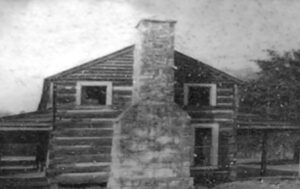
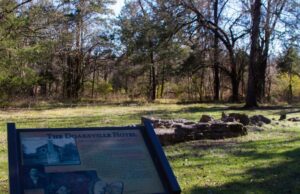 Today, a walking trail leads visitors through the site with interpretive signs telling the history of the old settlement. The old townsite has been designated as a National Historic Site, can be accessed through the Fort Towson Cemetery. A portion of the cemetery holds the burial sites of many important people who lived and died in Doaksville.
Today, a walking trail leads visitors through the site with interpretive signs telling the history of the old settlement. The old townsite has been designated as a National Historic Site, can be accessed through the Fort Towson Cemetery. A portion of the cemetery holds the burial sites of many important people who lived and died in Doaksville.

